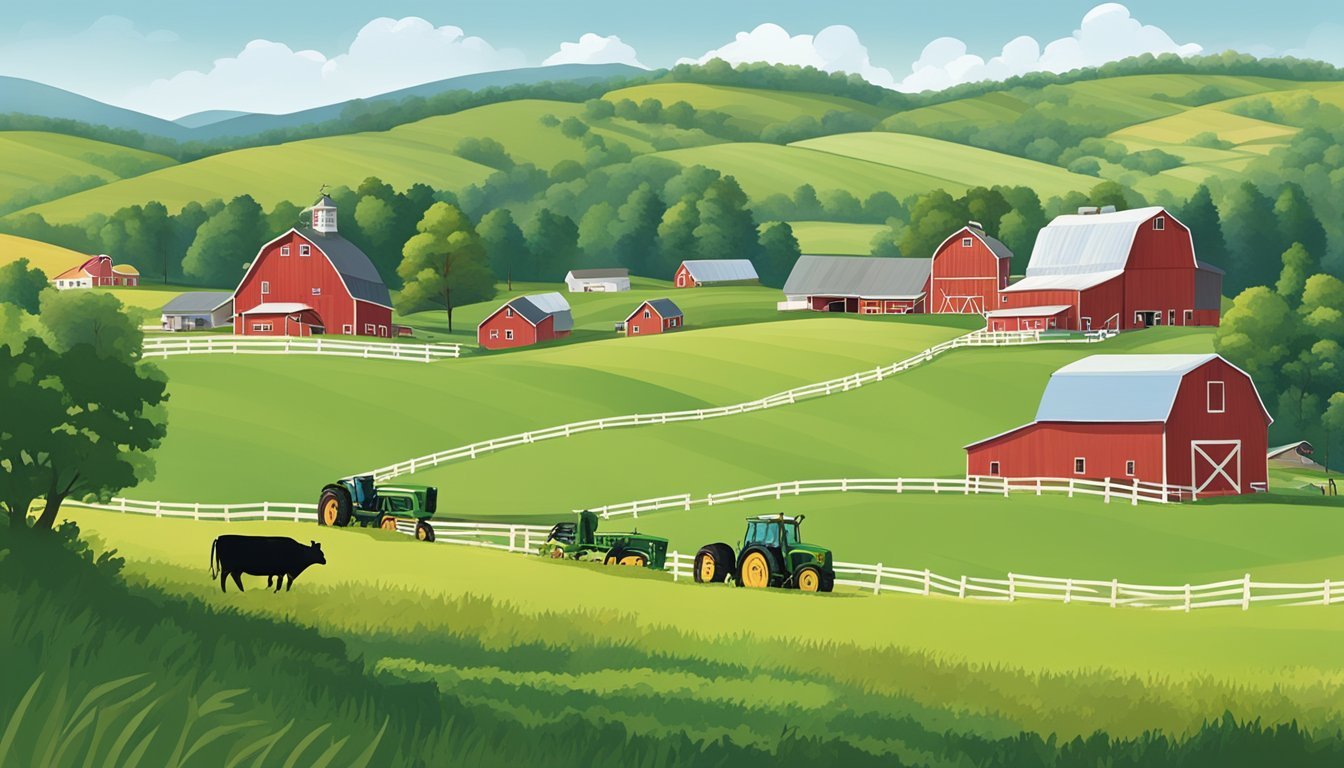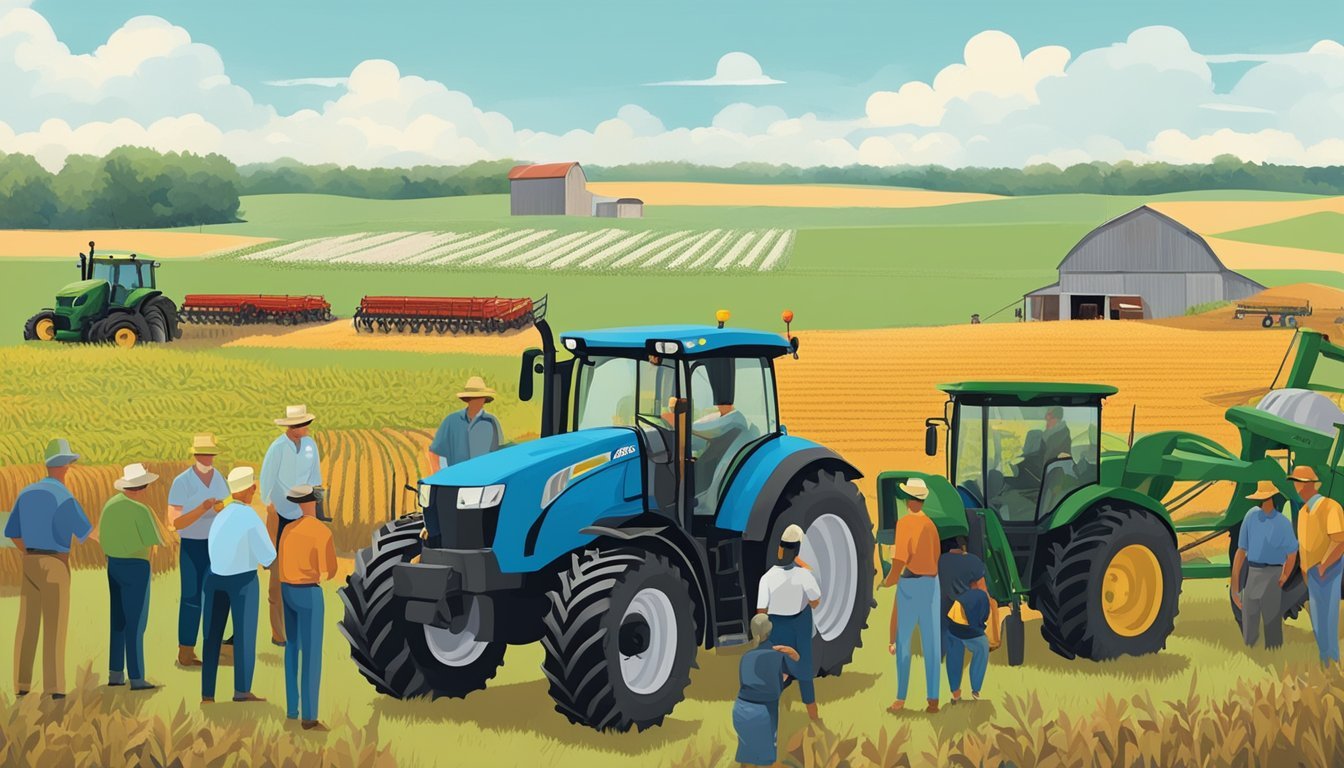Farming Communities in North Carolina
Sustaining Tradition and Innovation
Nestled in the heart of North Carolina, farming communities offer a unique blend of modern living and traditional agricultural roots. These areas provide not only fresh produce but also a lifestyle steeped in community values and sustainable practices. Olivette, a planned community located along the French Broad River, exemplifies this harmony with its vibrant vegetable, fruit, and flower farm, enhancing both the land and the lives of its residents.
Many farming communities in North Carolina also boast historic properties that have been meticulously preserved and updated. With 200 available properties that include old farmhouses and historic plantation homes, buyers can find a blend of modern amenities and rich history. Each acre of these properties is typically priced at $42,640, offering a substantial investment in both land and lifestyle.
Real estate in these areas is flourishing, with substantial options ranging from single-family homes to expansive country estates. Communities like those in Asheville and surrounding regions emphasize outdoor living, offering miles of walking trails and riverfront beaches. This lifestyle ensures that residents maintain a close connection to nature while enjoying the comforts of their picturesque homes.
Historical Overview of Farming in North Carolina
North Carolina's farming history stretches back to the colonial era. Initially, most residents lived on small family farms, sustaining themselves with crops like tobacco and cotton. By the mid-1800s, agriculture was the backbone of the State's economy.
The 1850s saw significant changes with the advent of improved farming techniques and equipment. This period marked the beginning of a transition towards more efficient agricultural practices.
In the early 20th century, agriculture faced challenges due to the Great Depression. Crop prices plunged, pushing many farm families into poverty. Many farms had no running water or electricity, making life difficult.
Despite the hardships, farming communities remained resilient. During this time, agricultural exports became more prominent, helping the state recover economically.
By 1920, the census revealed a national trend towards urban living. North Carolina, however, retained its agrarian roots. Even with industrial growth, much of the state's population continued farming.
Small family farms still thrive in North Carolina today, although the process has become more industrialized. The move towards modern practices includes increased use of machinery and advanced farming techniques.
Throughout its history, North Carolina has shown a strong commitment to its agricultural heritage. This enduring tradition highlights the importance of farming communities in the state's development.
Geographical Diversity and Agricultural Zones
North Carolina's diverse geography supports a variety of farming activities across its different regions. These zones include the Mountain Region, Piedmont Region, and Coastal Plain, each with unique crops and farming practices.
Mountain Region and Applicable Crops
The Mountain Region of North Carolina features higher elevations and cooler temperatures. This area is well-suited for crops like apples, Christmas trees, and various types of berries. Counties such as Washington and Tyrrell make a significant contribution to apple production, benefiting from the region’s climate and soil.
Additionally, vegetable farming in this region includes cabbage, potatoes, and greens, leveraging the cooler climate to grow high-quality produce. The region's community benefits economically from these crops, which also sustain local markets and festivals.
Piedmont Region and Livestock Farming
The Piedmont Region features rolling hills and a moderate climate, making it ideal for livestock farming. This area, including Stanly and Greene counties, is known for poultry, dairy, and cattle farming.
Livestock operations provide a significant source of income and employment for local communities. The presence of vast pastures in the Piedmont supports high-quality beef and dairy production. Additionally, Perquimans and Pasquotank counties contribute significantly to these farming endeavors, integrating modern techniques to improve yield and sustainability.
Coastal Plain and Specialty Farming
The Coastal Plain region, with its flat landscape and diverse soil types, supports a variety of specialty crops. This area, particularly Duplin and Hyde counties, excels in producing crops like peanuts, sweet potatoes, and tobacco.
Duplin County is renowned for its vineyards and wine production, while Hyde County makes significant contributions to the production of corn and soybeans. Farmers in the Coastal Plain rely on both traditional farming practices and modern technology to maintain productivity and combat environmental challenges. Local farming communities benefit from these specialty crops, which are integral to the regional economy.
Key Crops and Livestock in North Carolina
North Carolina's agriculture is diverse, with significant contributions from various crops and livestock. These key components play an essential role in the state's economy and food supply.
Soybeans and Corn: The Grain Capital
North Carolina produces substantial amounts of soybeans and corn. Corn is widely used both for livestock feed and as an ingredient in various food products. In 2023, North Carolina had thousands of acres dedicated to corn production. Corn also supports the state's ethanol industry.
Soybeans are another major crop, valued for their versatility. Soybeans are used in animal feed, human food products, and industrial applications like biodiesel. Both crops are vital, attracting investment and fostering the growth of farming communities.
Livestock: From Pasture to Market
Livestock farming is crucial in North Carolina, with beef cattle, swine, and poultry being the primary categories. The state is among the top producers of pork in the United States, and poultry farming—especially broiler chickens—represents a significant sector.
Beef cattle are found predominantly in the Piedmont and western regions. These livestock operations contribute significantly to the state's economy, supporting many related industries such as feed manufacturing, processing, and transportation.
Emerging Markets: Organic and Specialty Crops
Interest in organic and specialty crops is growing rapidly in North Carolina. Organic farming practices are becoming more common, driven by consumer demand for products free from synthetic chemicals. Specialty crops, including heirloom vegetables and niche fruits, are gaining popularity at farmers' markets and specialty stores.
The rise of these markets is fostering innovation and diversification. Farmers are experimenting with novel crops and organic methods, which enhance biodiversity and appeal to health-conscious consumers. This shift opens new revenue streams and strengthens the agricultural sector.
Socioeconomic Impact on Farming Communities
Farming communities in North Carolina are deeply influenced by a mix of small family farms, economic variability, and urban expansion. These factors play a significant role in shaping the livelihoods and economic stability of those who depend on agriculture.
The Role of Small Family Farms
Small family farms are vital to North Carolina's agricultural framework. They contribute significantly to the local economy while maintaining cultural traditions and biodiversity. These farms often rely on local markets and small-scale distribution networks.
Despite their importance, they face challenges competing against large food corporations. Economic pressures and land acquisition costs often push small farms to sell their land or consolidate operations.
Support programs from local and state governments aim to help these farms remain viable. However, access to financial and technical assistance remains a challenge.
Economic Swings and Farming
Economic swings strongly impact farming communities. Agricultural income can be volatile due to fluctuating market prices, unpredictable weather patterns, and changing consumer preferences. For instance, in a year when the price of a major crop drops, many farmers might struggle to break even.
The consolidated agricultural industry can buffer these impacts somewhat. For small farms, however, such swings might spell disaster without adequate safety nets.
Government subsidies, emergency relief programs, and crop insurance are crucial in helping farmers manage these fluctuations. Still, these measures are often just short-term fixes, and long-term stability remains elusive for many small-scale farmers.
Urban Development and Housing Costs
Urban development poses both opportunities and threats to farming communities. Expansion of housing projects and commercial spaces often means higher land values and increased property taxes, making it more expensive for farmers to maintain their land.
Rural areas near urban centers are particularly vulnerable. Farmers might be forced to sell their land to developers due to soaring housing costs.
Conversely, these developments can also expand markets for local produce as urban populations grow. Balancing development and agricultural needs is essential to maintain both economic growth and agricultural sustainability in North Carolina.
Environmental Practices and Challenges
For farming communities in North Carolina, environmental practices such as soil health management and water resource conservation are essential. This section explores the strategies and concerns within these vital areas.
Soil Health and Cover Crop Usage
Maintaining soil health is crucial for sustainable farming in North Carolina. Farmers use cover crops to prevent soil erosion and improve soil fertility. These plants, such as clover and rye, act as organic matter that enriches the soil.
Rotational planting is another method employed to combat soil depletion. By rotating different crops, farmers manage nutrient levels more effectively. The use of organic matter and reduced tillage also contributes to better soil structure, improving water infiltration and retention.
Climate change presents new challenges. Increased temperature and unpredictable weather patterns affect crop growth cycles. For instance, more frequent drought conditions strain soil quality. Mitigating these effects requires adaptive management and ongoing soil health assessments.
Water Resources and Irrigation
Efficient water management is critical given the variable climate and water availability in North Carolina. Farmers implement advanced irrigation systems, such as drip irrigation, to optimize water use. This method reduces water loss through evaporation and runoff, directing moisture precisely where it is needed.
Water conservation practices also include monitoring soil moisture levels and using sensor technology to adjust irrigation schedules. This data-driven approach minimizes water waste and supports crop health during dry spells.
Drought conditions complicate water resource management. Farmers must balance water use between crops and livestock, particularly in areas prone to water scarcity. Innovative solutions, like rainwater harvesting and groundwater recharge, are becoming more common.
These practices aim to maintain productivity while conserving vital water resources, ensuring the long-term viability of farming in North Carolina.
Technological Advancements in Agriculture
North Carolina's farming communities have seen significant technological advancements that are transforming agricultural practices. These innovations are essential for improving efficiency, crop yields, and resource management.
GIS and Precision Farming
Geographic Information Systems (GIS) and precision farming have become critical tools for North Carolina farmers. GIS allows for detailed mapping and data analysis of fields. This enables farmers to monitor soil conditions, moisture levels, and crop health with pinpoint accuracy.
Precision farming techniques utilize this data to apply water, fertilizers, and pesticides precisely where needed. This reduces waste and enhances crop productivity. For example, farmers use drones equipped with sensors to collect real-time data. This technology helps in making informed decisions quickly, ensuring optimal growth conditions for crops.
Innovations in Greenhouse Farming
Greenhouse farming has seen substantial innovations aimed at increasing efficiency and sustainability. Modern greenhouses in North Carolina use advanced climate control systems. These systems regulate temperature, humidity, and light. This provides ideal growing conditions year-round.
Automated systems have also been introduced to manage plant nutrients and watering schedules. Hydroponic systems are becoming popular, enabling plants to grow in nutrient-rich water instead of soil. These practices have allowed for higher yields and reduced resource usage. Additionally, greenhouses can protect crops from adverse weather, extending the growing season and providing a continuous supply of fresh produce.
Irrigation Systems and Crop Management
Improved irrigation technologies have greatly impacted crop management. Farmers are adopting smart irrigation systems that use sensors and IoT devices. These systems monitor soil moisture and weather conditions to optimize water usage. Drip irrigation systems are widely used in the state, providing water directly to the plant roots, reducing evaporation and runoff.
Crop management has also been revolutionized by technology. Software platforms help in planning, monitoring, and managing crop cycles. These tools provide data on planting times, pest management, and harvest projections. By automating many aspects of crop management, farmers can focus on increasing productivity and ensuring sustainability.
Regulatory Framework and Support Programs
Navigating the regulatory landscape and leveraging support programs is crucial for the thriving of farming communities in North Carolina. This section explores key initiatives and regulations impacting these communities.
USDA and Farm Service Agency Initiatives
The USDA and its Farm Service Agency (FSA) offer multiple initiatives to support farmers. Income Support Programs such as Agriculture Risk Coverage (ARC) and Price Loss Coverage (PLC) provide financial stability.
Farmers can also access Loan Assistance programs that help with purchasing land, equipment, and livestock. These loans often come with favorable terms tailored for agricultural needs.
Technical Assistance is another critical service, offering guidance on compliance with federal regulations and best practices in farming.
Environmental Protection Agency Regulations
The EPA enforces various environmental regulations crucial to farming practices. Laws like the Clean Water Act and Clean Air Act set standards that farmers must comply with to protect natural resources.
Permit Requirements may apply to activities like applying pesticides or managing waste. The agency's resources aim to help farmers understand and meet these regulations efficiently.
Compliance Assistance programs are available to help farmers navigate these complex rules, ensuring they operate within legal frameworks while preserving the environment.
Local and Federal Financial Assistance
Financial aid is available from both federal and state sources. Grants and subsidies from entities like the USDA can buffer against financial hardships caused by unpredictable agricultural conditions.
State Programs supplement federal aid, providing additional support tailored to North Carolina's specific agricultural needs. These initiatives often focus on boosting local production and safeguarding food security.
Cost-Share Programs are another avenue, where costs for conservation practices or innovations are partially covered by the state or federal government, easing the adoption of sustainable farming practices.
The Future of Farming in North Carolina
North Carolina's farming communities are facing multiple challenges and opportunities shaped by consumer behaviors, global events, and technological advancements. These factors are vital for the future of farming in the state.
Adapting to Shifting Consumer Behaviors
Farmers in North Carolina are increasingly aligning their practices with consumer preferences for locally-sourced, organic, and sustainable products. Changing climate and growing interest in health-conscious eating are driving this trend.
Producers are adopting regenerative agricultural practices to meet these demands. Efforts are also focused on reducing carbon footprints, and implementing water conservation techniques. The shift towards transparency in farming methods is crucial. This change is seen not just in direct consumer sales but also in larger supply chains.
Impact of Global Events on Local Farming
Global events such as the Covid-19 pandemic and the Russian invasion of Ukraine have highlighted vulnerabilities in food supply chains. Disruptions have led to increased costs for seeds, fertilizers, and other inputs due to fluctuating interest rates and international trade barriers.
North Carolina's farmers are adjusting by diversifying crops and employing more resilient farming techniques. The pandemic emphasized the importance of local supply chains, prompting many farmers to enhance local distribution networks. This ensures better access to markets during times of international instability.
Community and Tech-Driven Agricultural Growth
Collaboration between farming communities and local organizations is pivotal for sustainable growth. Data-driven technologies are being extensively integrated to enhance yield and reduce waste. Drones, IoT sensors, and precision farming tools are being used for real-time monitoring of crop health and soil conditions.
Community initiatives focus on hazard mitigation and advocate for sustainable practices. Engaging with educational institutions and tech startups enables North Carolina's farmers to innovate and stay competitive. These technological advancements not only increase productivity but also make farming more appealing to the younger generation, securing the agriculture industry’s future.
Farmers and local communities working together, bolstered by advanced technology, offer a promising pathway for the future of agriculture in North Carolina.








